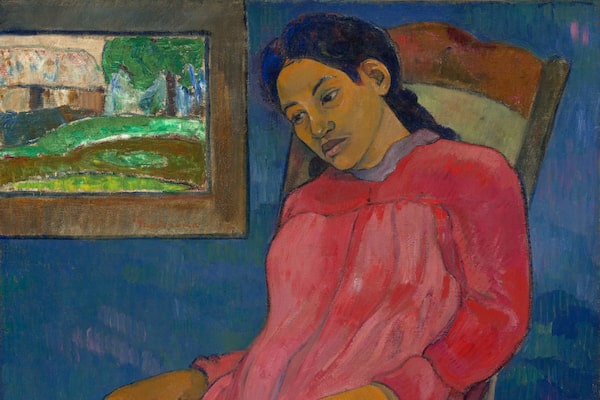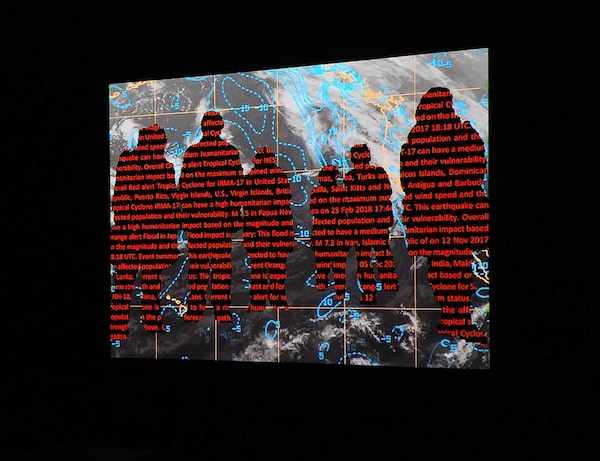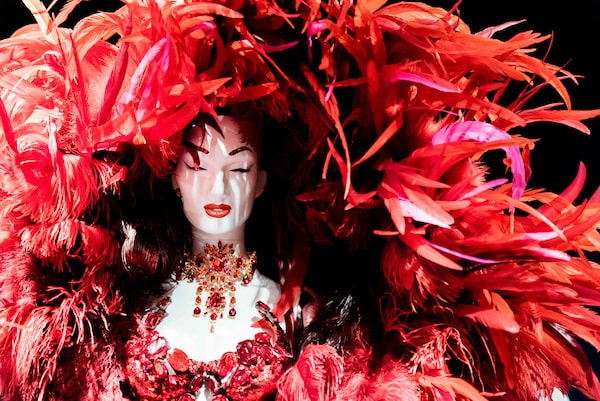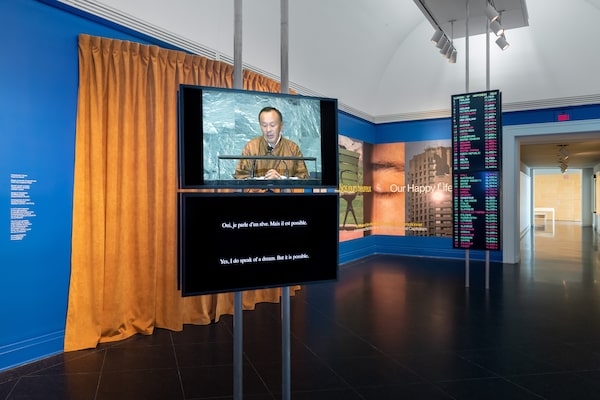Plan your gallery-hopping in …
Vancouver
There Is Truth Here: Creativity and Resilience in Children’s Art from Indian Residential and Day Schools (Vancouver Art Gallery)

Museum of Vancouver
There Is Truth Here was organized by the University of Victoria, where it was on view first. Following many years of research by anthropologist Andrea Walsh, who curated the show in collaboration with survivors and their families, the show offers a different way into this dark chapter of Canadian history, when Indigenous children were taken from their families and sent to these schools with the objective of assimilation. Abuse was rampant, but some children were permitted to make art – this exhibit is the emotional, grounding result of that. (Until January, 2020)
Alberto Giacometti: A Line Through Time (Vancouver Art Gallery)

Man Walking (Version I), 1960.Albright-Knox Art Gallery/Estate of Alberto Giacometti/SOCAN
A Line Through Time was organized by the Sainsbury Centre for the Visual Arts in Britain in collaboration with the VAG. Giacometti’s most famous works are his sculptures: emaciated, elongated bronze human figures that suggest a strong sense of alienation, even a risk of disappearance. But Giacometti was a prolific, insatiable practitioner of many mediums, and his drawings, lithographs, paintings and biographical ephemera also on display serve to contextualize his life. (Until Sept. 29)
Toronto
Treasures of a Desert Kingdom: The Royal Arts of Jodhpur (Royal Ontario Museum)

Folio 53 from the Shiva Rahasya Jodhpur, 1827.ROM
India ceased to officially recognize its royal titles in 1971, but as custodians of their ancestors’ treasures, the Rathores of Jodhpur have embraced the democratization of globalized culture. And so, Treasures of a Desert Kingdom: The Royal Arts of Jodhpur, an exhibition of prized objects rarely seen outside India, is making a North American tour with one Canadian stop at the ROM. The collection ranges from historic jewels, armaments and paintings, to the dazzling aluminum Rolls-Royce that the current Maharaja’s grandfather commissioned in 1927. The exhibition addresses artisans’ craft, princely power and the role of royal women, if not India’s vast discrepancies of wealth. (Until Sept. 2)
In the Age of Rembrandt (Royal Ontario Museum)
Two portraits by Rembrandt, Reverend Johannes Elison, centre, and Maria Bockenolle (wife of Johannes Elison), right.Fred Lum/The Globe and Mail
This exhibit from Boston’s Museum of Fine Arts is a testament to the remarkable depth and spread of painting in the Netherlands in the 17th and 18th centuries, but it’s one that positions the work as a social document as much as a cultural achievement. While true to its name it includes three Rembrandt portraits, most of the works featured are wonderfully obscure, bringing to audiences paintings better known to art historians than the general public. (Until Sept. 15)
Vija Celmins: To Fix the Image in Memory (Art Gallery of Ontario)

Vija Celmins, Untitled (Ocean), 1977. Graphite on acrylic ground on paper, 25.4 x 32.7 cm. San Francisco Museum of Modern Art, bequest of Alfred M. Esberg © Vija Celmins. Photo: Don Ross, courtesy the San Francisco Museum of Modern ArtSan Francisco Museum of Modern Art
The New York artist, now 80, created her ocean series from photographs of the sea when she was living in Venice, Calif., in the 1960s. And her point is that these painstaking drawings, currently showing at the Art Gallery of Ontario, were never intended to represent the water. Indeed, she quickly corrects a curator who unthinkingly uses the word “representation.” So, if they are not intended as seascapes, what are these drawings “about”? Celmins’s interest, whether in the ocean drawings or equally magnificent renditions of the moon’s face and the desert’s floor, lies in the surface of the art. Stripping her work of symbolism, she has spent decades interrogating two-dimensionality just as surely as the towering male abstractionists who she followed in her youth made theirs a quest for flatness. (Until Aug. 5)
Brian Jungen: Prototype of New Understanding and Friendship Centre (Art Gallery of Ontario)
Brian Jungen, Prototype for New Understanding #5, 1999.Trevor Mills/Vancouver Art Gallery / Courtesy of the Art Gallery of Ontario
Brian Jungen’s clever disassembling of consumer sports gear to make Indigenous masks, headdresses and totems feels like a particularly timely and necessary art for a Canada attempting reconciliation. His work compares the modern mass-produced consumer good with the historic hand-crafted art, suggesting layers of references to sporting competition as a replacement for actual battle, from the feathered war bonnets to white appropriation of Indigenous personas for athletes and teams. The 20 pieces that are part of Prototype of New Understanding, created between 1998 and 2005, are installed within the second exhibit, a mock basketball court called Friendship Centre created by Jungen and contemporary curator Kitty Scott. (Until Aug. 25)
Joana Hadjithomas and Khalil Joreige, On Scams; Mario Pfeifer, If you end up with the story you started with, then you’re not listening along the way; Thomas J Price, Ordinary Men (The Power Plant Contemporary Art Gallery)
Henry Chan Jr./Supplied
The Power Plant gallery at Harbourfront Centre is putting on a summer exhibition schedule about globalism, race and video art. Three key pieces, acting almost as small exhibitions on their own, are on display: On Scams, Joana Hadjithomas and Khalil Joreige’s collection of 4,000 emails in response to the online scams that continue to proliferate despite seemingly outlandish schemes; Mario Pfeifer’s collection of short, intricate films, called If you end up with the story you started with, then you’re not listening along the way; and Thomas J Price’s thoughtful sculptures about race, titled Ordinary Men. As always with the Power Plant’s fruitful combinations of international artists, there’s an interesting dialogue to be found here. (Until Sept. 2)
Hamilton
This is Serious: Canadian Indie Comics (Art Gallery of Hamilton)
Supplied
Why is Canada such fertile territory for indie comics? This show begins with some history, explaining that in the 1950s through the 1970s Canadian readers (and future indie cartoonists) were introduced to comics by mainstream newspaper artists. Curators Alana Traficante and Joe Ollmann (himself a graphic novelist) take a regional approach here, using the burgeoning Hamilton as an example of the intense urbanization that seems to inspire the humour and the angst of so many illustrators. They then spread out to offer a national survey that introduces the viewer to an almost overwhelming number of current artists. (Until Jan. 5, 2020)
Ottawa
Gauguin Portraits (National Gallery of Canada)

Melancholic (Faaturuma), 1891.Nelson-Atikins Media Services/Chris Bjuland and Joshua Ferdinand
In 1891, artist Paul Gauguin arrived in the French colony of Tahiti looking for an exotic paradise and convinced that he could make money painting local clients. This exhibition, assembled for NGC by the independent curator Cornelia Homburg and for the National Gallery in London by its curator Chris Riopelle, argues that Gauguin’s portraits always served his art rather than his sitter in their experimentation. His concern was technique and philosophy, not physiognomy and psychology. The exhibition is a first: No one has ever assembled Gauguin’s portraits before, perhaps because, as it proposes, they aren’t really portraits at all. (Until Sept. 8)
Cheryl Pagurek: Connect, Juan Geuer: Carbon + Light, Howie Tsui: Retainers of Anarchy (Ottawa Art Gallery)

Cheryl Pagurek, Connect, 2016-ongoing, interactive video and audio installation.Courtesy of the artist
This threefold collection strives to address the topic on many minds: our relationship with and reliance on technology. The gallery’s string of summer exhibitions by artists Cheryl Pagurek, Juan Geuer and Howie Tsui initiates the conversation surrounding technology, art and audience through engaging and interactive exhibits, including Pagurek’s Connect, an interactive video installation, and Tsui’s Retainers of Anarchy, an animated scroll that experiments with visual storytelling. (Cheryl Pagurek: Connect is on until Aug. 11; Juan Geuer: Carbon + Light until Aug. 18; and Howie Tsui: Retainers of Anarchy until Sept. 15)
Montreal
Thierry Mugler: Couturissime (Montreal Museum of Fine Arts)

MARTIN OUELLET-DIOTTE/AFP/Getty Images
Viewers will see Mugler – and this six-part exhibition – move into difficult territory as his clothing designs through the years are spotlighted in a series of rooms. The second room, for example, is filled with Mugler’s fashion designs from the 1980s, and there is little here to make you miss the decade of excess. Plunging bodices, padded shoulders, sequined corselets, trailing tail feathers – pinned onto immobile mannequins in a museum setting, the clothes look garish and dated. Yes, fashion is art, and Mugler transformed the runway show into a staged spectacle. (Until Sept. 8)
Our Happy Life: Architecture and Well-being in the Age of Emotional Capitalism (Canadian Centre for Architecture)

CCA
This Montreal show takes a broad view of how a new “science of happiness” may be affecting the built environment. Our Happy Life: Architecture and Well-being in the Age of Emotional Capitalism ponders the flood of data about personal happiness that, during the past decade, has helped make happiness a political topic and a social commodity. The show asks how the proliferation of happiness surveys and more covert measures of emotion may be changing city planning and architectural practice, especially within the bounds of “emotional capitalism." (Until Oct. 13)
Yoko Ono: Liberté Conquérante/Growing Freedom

Yoko Ono, Helmets (including Pieces of Sky).Studio One
The Liberté Conquérante/Growing Freedom exhibition focuses on the “instruction paintings” Ono began creating in the mid-1950s, the films and music she made with Lennon and the weeklong Bed-In for Peace the couple held at Montreal’s Queen Elizabeth Hotel 50 years ago in May. There’s also a new instruction piece called Arising, which invites women to “send a testament of harm done to you for being a woman,” with a photo of the writer’s eyes. There were already 400 testaments on display when the show opened on April 25. (Until Sept. 15)



